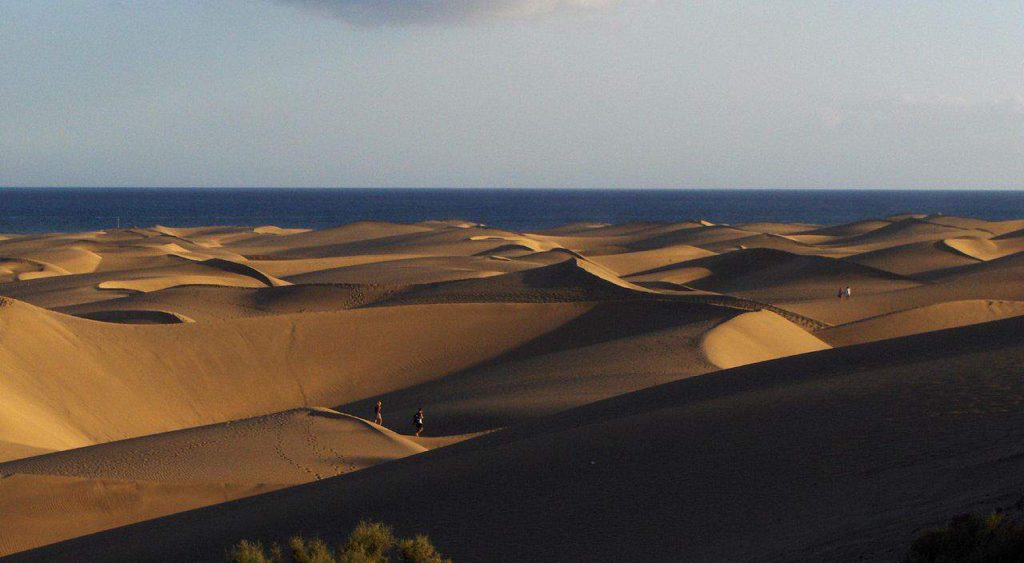Gran Canaria Island is called a «Miniature Continent» due to the different climates and variety of landscapes found, with long beaches and dunes of white sand, contrasting with green ravines and picturesque villages. A third of the island is under protection as a Biosphere Reserve by UNESCO.
Due to the ease of access it is a very visited island:
Airport
Gran Canaria Airport is the only commercial airport on the island. The large number of aircraft and passengers passing through it each year make it one of the busiest in Spain. Gran Canaria is also responsible for all air traffic control in the Canaries. By destination island, Gran Canaria is the second island that congregates the largest number of passengers in the Canary Islands.
Sea ports
The most important ports in the island are the Port of Las Palmas (Puerto de la Luz), in the city of Las Palmas de Gran Canaria; Arguineguín, and Arinaga, located in the main industrial zone of Canaries and one of the major ones of Spain.
The main passenger ports are the Port of La Luz, where a weekly ferry operates the route to Cadiz on the Spanish mainland, and the Port of Las Nieves, located in Agaete on the west side of the island, where operates a catamaran ferry service to Santa Cruz of Tenerife.
Most of the tourists visit the southern part of the island. The north tends to be cooler, while the south is warmer and sunny. The east coast of the island is flat, dotted with beaches, while the western coast is rockier and mountainous.
In the island are 32 Natural Protected Spaces, notably the Rural Park of Nublo, The Doramas Jungle, the Azuaje Ravine, Tamadaba, Pino Santo, etc.
In the south there is a large bird park, Palmitos Park, as well as many beach resort communities. Resorts are concentrated in the central eastern part of the southern coast in the Maspalomas area, which includes the towns of San Agustín, Playa del Inglés and Meloneras. The Maspalomas Dunes are located between Playa del Inglés («The Englishman’s Beach») and the distinctive 19th century Maspalomas lighthouse. Playa del Ingles is home to the Yumbo Center, which was opened in 1982 and has almost 200 shops, including bars, restaurants, cafes, fashion boutiques, electronic outlets and jewelery stores.
In Tarajalillo, an Aeroclub exists from where tourist flights can be taken over the island.
Still further to the west along the southern shore, in the Municipality of Mogán, are the communities of Puerto Rico and Puerto de Mogán, a village referred to as «Little Venice» on account of its many canals.
Other attractions include Cocodrilos Park, Roque Nublo (an 80 m monolith), Cenobio de Valerón with more than 350 storage cavities, Painted cave of Galdar the most important archaeological park in Canary Islands, or the botanical gardens Jardín Canario (in Tafira Alta) and Cactualdea (in The Village of San Nicolás).
Other well-known rock formations are El Cura (also known as El Fraile), The Frog (La Rana), Roque Bentayga, the Roque de Gando, and the Peñón Bermejo. The highest peak of the island is the Pico de las Nieves, at 1,950 meters (6,400 ft).
The capital city is Las Palmas de Gran Canaria. Las Canteras beach, a protected area and diving zone, lies in the heart of the city. Las Palmas de Gran Canaria is also known for its annual carnival. It was the first stop of Christopher Columbus’ expedition on his way back from the Americas, a commemoration of which is the Hermitage of San Antonio Abad, where the navigator prayed, and the Casa de Colón. Other attractions in the capital city include the Canarian Museum (the most important archeology museum in the archipelago), the cathedral and the Plaza del Espiritu Santo. In Teror the shrine of Virgen del Pino («Virgin of the Pine»), patron saint of Gran Canaria, can be found. Its feast is celebrated on September 8.
The town of Agüimes, on the eastern part of the island, has been carefully restored and its town center, centered on its old church and a peaceful square, now evokes the quiet living of a traditional Canarian town. The district also has some of the best preserved cave dwellings, in the protected area of the Guayadeque ravine, where even the church has been built into the mountainside and visitors can find a number of popular cave restaurants. The district also includes the most renowned scuba diving area on the island: the marine reserve at the El Cabrón beach just outside the town of Arinaga.
Other important towns are Telde, known among other things for their surf schools in Salinetas, Vecindario (within the municipality of Santa Lucía de Tirajana) and Gáldar, that contains an important diving zone. In Arucas there is a Neogothic temple, popularly known as «Arucas’ Cathedral», as well as a large fertile plain where bananas are grown. In Gáldar and its surroundings there is also a banana-growing plain and some remarkable archaeological remains such as the Painted cave of Galdar or the Cenobio de Valerón’s communal silos, ancient tombs (among which the necropolis of Maipés), and the port of Sardina del Norte (one of the island’s ports where, as in Las Palmas’, Christopher Columbus used to get supplies for his ships).
Heading west along the southern coast is the fishing city of Arguineguín in the Municipality of Mogán.
Iberinbound, incoming leisure travel agency specialized in Spain and Portugal, Shorex, Groups and also Groups ad-hoc by request, Luxury and VIP destinations iberinbound@iberinbound.com Our knowledge of the country and efficient negotiation with our suppliers ensures the best value for money for our clients.


